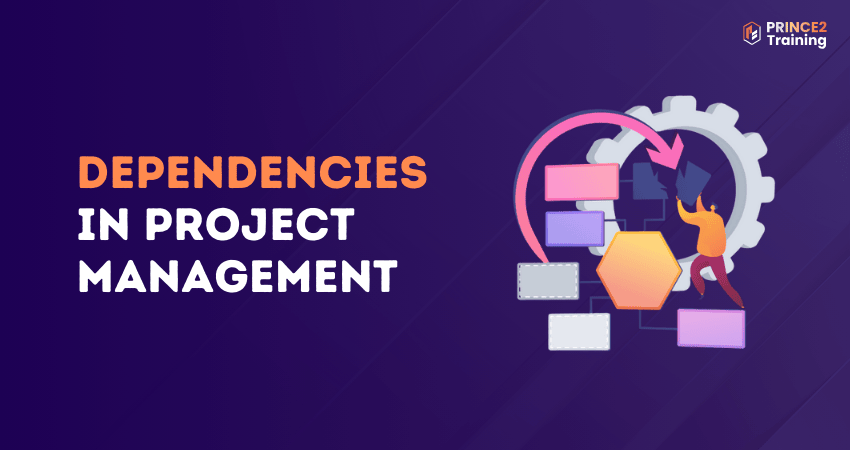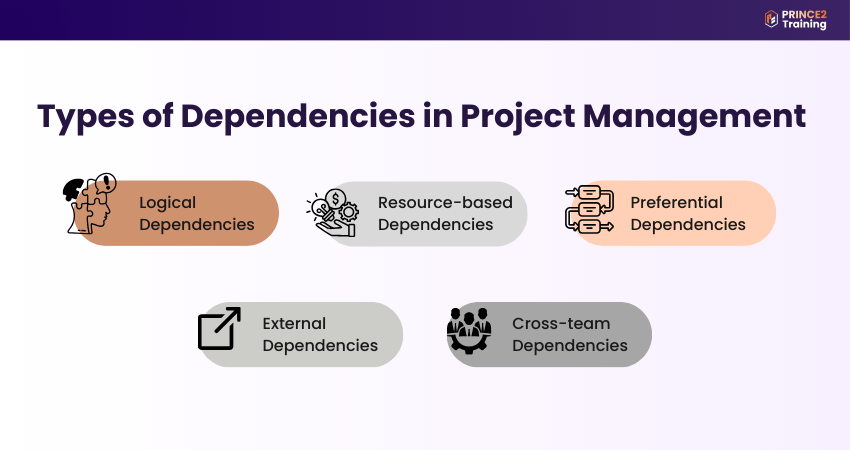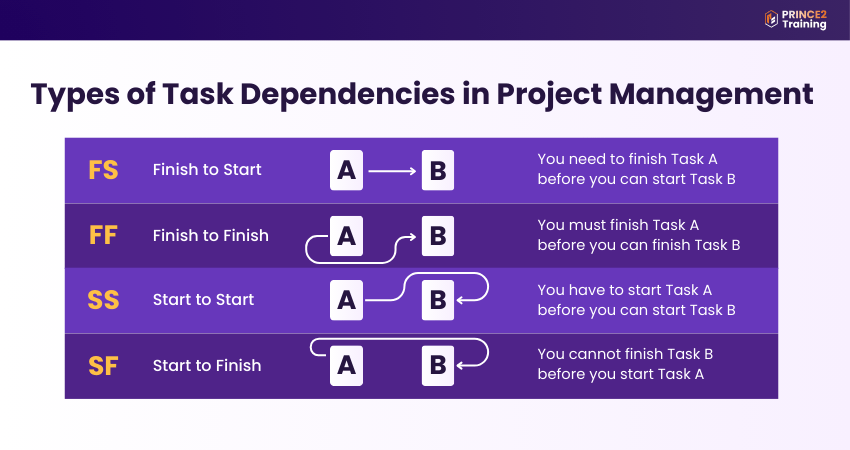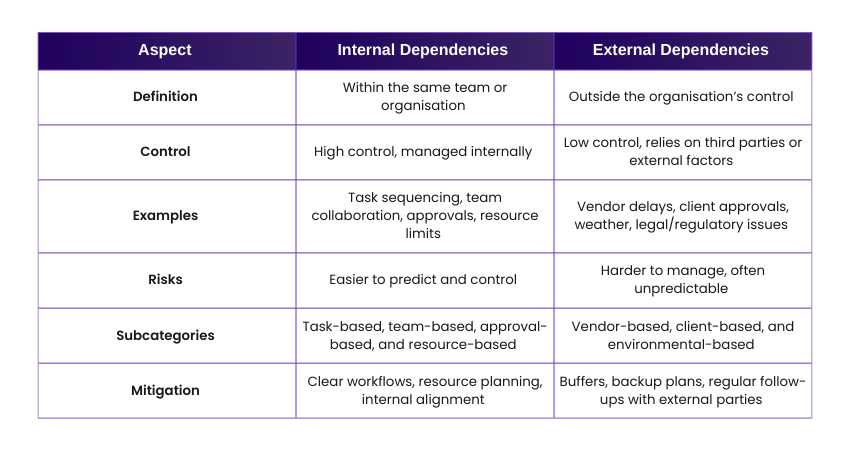Table of Contents

Your team is ready. The deadline is close. But one task is on hold, and everything else has to wait. It’s not poor planning. It’s not your team’s performance. Rather, it is a hidden link in your project chain that was missed, ignored, or underestimated.
In Project Management, even the most capable teams can’t move forward without understanding how tasks rely on each other. Dependencies are the silent drivers of project flow, and one weak link can bring everything to a halt. When they are clear and managed well, your team moves faster and your project flows with ease. In this blog, we will walk you through Dependencies in Project Management, their types, examples, and tools. Let's delve into it!
Table of Contents
1) What are Dependencies in Project Management?
2) Key Terms Related to Dependencies
3) Types of Dependencies in Project Management
4) The Four Types of Task Dependencies in Project Management
5) How to Manage Dependencies in Project Management?
6) Benefits of Effective Dependency Management in Project Management
7) What is the Difference Between External and Internal Dependencies?
8) What is the Difference Between External and Internal Dependencies?
9) Conclusion
What are Dependencies in Project Management?
In Project Management, Dependencies refer to the relationships between tasks or activities, where the starting or ending of one task relies on the start or finish of another. These connections determine the sequence of work and are essential for planning realistic timelines.
It is also important for the teams that undergo development using Scrum or Agile Methodology. For example, if you’re building a website, you can’t begin testing it until the development is complete. Here, testing is dependent on the completion of development.
Key Terms Related to Dependencies
Before diving into the types of Dependencies, let’s know some of the key terms used:
1) Project Constraints
Project constraints are the core limitations or boundaries that impact any project execution. These are typically represented by the Project Management Triangle, made up of:
1) Cost: The budget allocated to complete the project
2) Time: The duration required to finish the project
3) Scope: The work required, including deliverables, goals, and features
2) Critical Path
The critical path is the longest sequence of dependent tasks that determines the shortest possible time to complete a project. If any task on the critical path is delayed, the entire project will be delayed. The Critical Path Method (CPM) is a project planning technique used to:
1) Identify which tasks are critical vs non-critical
2) Visualise task dependencies and timelines
3) Calculate the expected project duration
3) Blockers
Blockers are anything that stops a task from progressing. Identifying them early helps reduce risks, avoid schedule disruptions, and keep workflows moving smoothly. These blockers can be:
1) Internal, such as a team member being unavailable or waiting on internal approval
2) External, such as vendor delays or missing deliveries
Types of Dependencies in Project Management
Now, it is time for you to explore the five common types of Dependencies in Project Management:

1) Logical Dependencies
These are essential and unavoidable kinds of Dependencies. They follow a natural workflow and can’t be skipped or done in parallel. They form the backbone of most project plans.
Example: In construction, laying the foundation must come before building the walls. Skipping this order won’t be structurally possible.
2) Resource-based Dependencies
These arise when two or more tasks share the same limited resource, such as a team member, tool, or machine. Since the resource can’t be in two places at once, the tasks must be sequenced.
Example: If the same Graphic Designer is needed for two different design tasks, one must wait until the other is done.
3) Preferential Dependencies
These are based on best practices, team preferences, or industry norms rather than necessity. While the project could still run without them, skipping these dependencies may impact quality or efficiency.
Example: Conducting a user review before deployment isn’t mandatory, but it is a preferred step to ensure fewer post-launch issues.
4) External Dependencies
These come from outside the organisation’s control, often involving third parties or environmental factors. Since they are unpredictable, they carry a higher risk and require proper backup planning.
Example: A task waiting on regulatory approval from a government body before proceeding.
5) Cross-team Dependencies
Common in large or complex projects, these occur when multiple teams or departments must coordinate. One team’s progress may depend on another team’s output.
Example: The development team can’t build a feature until the design team finalises the User Interface (UI).
Build a strong foundation in Project Management with our PRINCE2® Foundation Training – Register today!
The Four Types of Task Dependencies in Project Management
So far, you have an understanding of the types of Dependencies. Now, you need to know the four Types of Task Dependencies in every project:

1) Finish-to-Start (FS)
In this type of dependency, Task B cannot start until Task A is finished. This is the most commonly used relationship in project planning.
Use Case: Ideal for tasks that must be done in strict order, such as content creation, construction stages, or approval chains.
Tip: Use FS dependencies to create a logical workflow and identify bottlenecks early by highlighting which tasks can’t begin until others are done.
2) Finish-to-Finish (FF)
With this Dependency, Task B can’t finish until Task A is completed. The tasks are related by their completion, not their start.
Use Case: Perfect for tasks that must be completed simultaneously for final delivery or sign-off.
Tip: Applying FF dependencies when syncing end dates is crucial, like launch campaigns, system cutovers, or coordinated releases.
3) Start-to-Start (SS)
Here, Task B can’t start until Task A starts. The tasks begin at the same time or close together, but may finish at different times.
Use Case: Useful for overlapping tasks that depend on a common start but don’t necessarily have to end together.
Tip: Use SS to shorten the timeline by allowing tasks to run concurrently. However, you need to ensure both teams are ready to begin together.
4) Start-to-Finish (SF)
In this unusual Dependency, Task B can’t finish until Task A starts. It is less intuitive but useful in specific situations.
Use Case: Useful in time-bound operations such as shift changes, 24/7 support, or live handovers.
Tip: Use SF only when there is a clear need for overlap in shifts or responsibility transitions. Always communicate clearly to avoid confusion.
Lead high-performing, flexible projects with our PRINCE2 Agile® Foundation and Practitioner Training – Sign up soon!
How to Manage Dependencies in Project Management?
Here are the steps for managing Dependencies in Project Management:
1) Identify and Document All Dependencies
Start by analysing your project to spot where Dependencies exist. Brainstorm with your team, involve cross-functional stakeholders, and don’t overlook hidden or informal dependencies. Record them all in your project documentation.
Benefits Include:
1) Building accurate timelines and realistic schedules
2) Estimating project duration more effectively
3) Managing stakeholder expectations better
2) Establish the Critical Path
Once your dependencies are documented, apply the Critical Path Method to identify the tasks that will directly impact the project’s timeline. With this, you can highlight the priority tasks that must stay on track and determine where flexibility exists without delaying the project.
Key Actions:
1) Identify the longest sequence of dependent tasks
2) Focus on tasks with the most impact on the overall schedule
3) Use Dependency diagrams or scheduling software to map timelines
3) Keep Stakeholders Informed
Transparency is key when managing Dependencies. Use Project Management platforms with built-in communication tools like task comments, notifications, file sharing, etc., to keep everyone aligned.
To Keep Stakeholders Informed:
1) Provide regular updates through status meetings or dashboards
2) Communicate Dependency-related changes early
3) Invite external stakeholders for relevant project discussions
4) Track and Mitigate Risks
Every dependency carries some level of risk, especially those involving external factors. You can try using risk registers to monitor high-risk dependencies and develop proper backup plans for worst-case scenarios.
To Minimise Impact:
1) Track Dependency during stand-ups or progress meetings
2) Identify high-risk links early, like vendor approvals, shared resources
3) Create backup plans or schedule buffers for key Dependencies
5) Organise Tasks with Project Management Tools
Modern Project Management tools make it easier to map, track, and adjust Dependencies across teams and timelines. With visual aids like Gantt charts, task boards, and calendars, you can manage complex workflows with greater clarity and control.
To Organise Tasks Effectively:
1) Link dependent tasks to reflect real workflow sequences
2) Use drag-and-drop features to reschedule tasks instantly
3) Create dashboards for a clear overview of progress, delays, and bottlenecks
Become a confident, certified Project Leader with our PRINCE2® Practitioner Training – Join now!
Benefits of Effective Dependency Management in Project Management
Let's check the benefits of practising effective Dependencies in Project Management:
1) Improved Planning Accuracy: You can create more realistic timelines by knowing which tasks influence others.
2) Enhanced Team Collaboration: Clear Dependencies foster accountability and coordination between team members and departments.
3) Risk Mitigation: Spotting Dependencies early allows teams to plan workarounds and avoid last-minute surprises.
4) Time and Cost Efficiency: Efficient workflows reduce idle time and resource conflicts, preventing delays and budget overruns.
5) Better Quality Control: Dependencies ensure that essential tasks, such as testing or reviewing, are not skipped or rushed.
What is the Difference Between External and Internal Dependencies?
External dependencies involve factors or parties outside the project team, while internal dependencies exist within the team or organisation. Understanding both helps in better planning, coordination, and risk management.

Conclusion
Dependencies in Project Management are the invisible threads that hold your project together. When managed well, they ensure every task flows smoothly into the next, keeping timelines realistic, teams aligned, and goals within reach. So, take the time to map your Dependencies, and make them part of your planning process.
Are you ready to take control of your projects? Explore our PRINCE2® Certification to lead with confidence!




 Back
Back


 Back to
topics
Back to
topics









